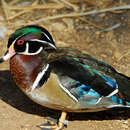More info for the terms:
hardwood,
mastOvermature trees and snags should be left on logging sites for wood duck
nesting cavities. Mixed stands of trees, including those producing mast
and/or providing nesting cavities, should be left on these sites. Elm
(Ulmus spp.) and maple are an important component of wood dick habitat
because they provide both [
5]. Nest boxes constructed of wood, metal,
or plastic can be used in areas where cavities are limited. If placed
in direct sunlight, however, plastic or metal may reach internal
temperatures high enough to kill embryos. For detailed information on
constructing nest boxes, refer to the U.S. Fish and Wildlife Service
[
14].
In bottomland hardwood sites where flooding is controlled, it is
important to maintain a flooding regime that promotes oaks that bear
small acorns. Overcup oak (Quercus lyrata) produces large acorns which
are usually unsuitable as wood duck food [
5]. Water depths in foraging
areas should be maintained at levels less than 8 inches (20 cm), but can
be deeper in resting and roosting sites. Detailed information for
managing flood-controlled wetlands for wildlife habitat across the
United States is available [
4].
Bottomland hardwood sites need openings to increase the growth of mast-
producing oaks. Their growth is stunted under closed canopies [
11].
Openings can be created by thinning or select cutting.
Long-term studies indicate that growth of trees on greentree reservoir
sites (GTRs) is reduced by several years of flooding. However, there
is no indication that this poses any threat to wildlife, such as
wintering wood ducks, that use GTRs. Flooding GTRs is recommended from
mid-September in the North and continuing through mid- to late October in
the South. Drawdown should begin in mid-February [
11].
REFERENCES : NO-ENTRY

